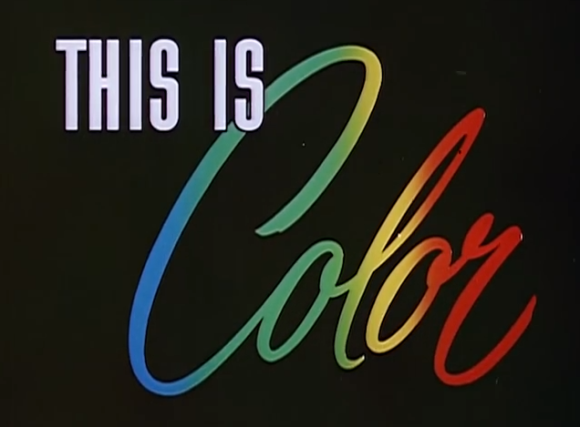 Chances are, you take color for granted. Whether or not you give it much thought, color is key to distinguishing your surroundings. It helps you identify fire, brown recluse spiders, and the right resistor for the job.
Chances are, you take color for granted. Whether or not you give it much thought, color is key to distinguishing your surroundings. It helps you identify fire, brown recluse spiders, and the right resistor for the job.
In the spotlight this week is a 1950s educational film called “This is Color“. It also happens to be a delightful time capsule of consumer packaging from the atomic age. This film was made by the Interchemical Corporation, an industrial research lab and manufacturer of printing inks. As the narrator explains, consistent replication of pigments is an essential part of mass production. In order to conjure a particular pigment in the first place, one must first understand the nature of color and the physical properties of visible light.
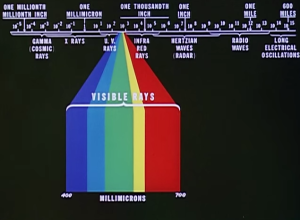 Each color that makes up the spectrum of visible rays has a particular wavelength. The five principal colors—red, yellow, green, blue, and violet—make possible thousands of shades and hues, but are only a small slice of the electromagnetic spectrum.
Each color that makes up the spectrum of visible rays has a particular wavelength. The five principal colors—red, yellow, green, blue, and violet—make possible thousands of shades and hues, but are only a small slice of the electromagnetic spectrum.
When light encounters a transparent material more dense than air, such as water or glass, it has to change direction and is bent by the surface. This is known as refraction. A straw placed in a glass of water will appear bent below the surface because the air and the water have different refractive indices. That is, the air and water will bend or refract different percentages of the light that permeates them.
When light encounters a smooth, solid surface, reflection is focused in one direction. A rough surface reflects light in all directions because the light hits so many different angles. This phenomenon is the basis for manufacturing knowledge about printing inks, lacquers, dyes, and chemical coatings. This is demonstrated with a coating made from linseed oil and glass that has been ground into a fine powder. Here, the linseed oil acts as a vehicle, and the glass as a pigment of the most basic form: fine particles of an insoluble substance suspended in the linseed oil. The refractive index (RI) of the linseed oil is different from that of air, so the light that permeates it is partially reflected.
If the RI of the pigment is the same as the vehicle, light will pass through to the surface begin coated and there will be no reflection. The coating is transparent. If the surface is white, nearly all the light will be reflected back through the coating. A black surface will reflect almost none of the light.
However, if the RI of the pigment differs from the RI of the vehicle, reflection occurs at each particle of the pigment. If it is thick enough, enough reflection occurs that the surface color will not be visible. The coating is opaque.
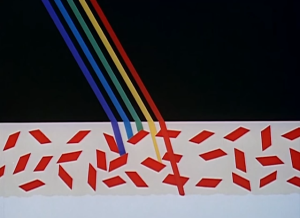 To reveal the relationship of colored pigments and light, we are shown the effect of several colors of glass. Each color of glass has all of the spectral colors inherent in it, but only certain colors are passed through while the others are absorbed. This experiment makes it possible to create graphs of the wavelengths that each spectral color transmits.
To reveal the relationship of colored pigments and light, we are shown the effect of several colors of glass. Each color of glass has all of the spectral colors inherent in it, but only certain colors are passed through while the others are absorbed. This experiment makes it possible to create graphs of the wavelengths that each spectral color transmits.
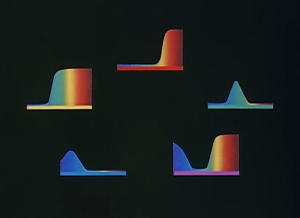
Using a device called a spectrophotometer, which measures the amount of light that is reflected or absorbed by a material at all points in the spectrum, the fine folks at Interchemical Corporation can nail down the exact green they need for a package both initially and for every production run thereafter. We are now equipped to understand the subtractive process of printing the color green: yellow and blue do not make it, but instead leave it. Really, though, they allow it to be transmitted.
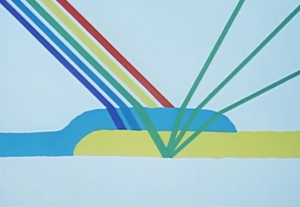
Green occurs in the overlap of the reflectance curves of yellow and blue. This is another way of visualizing the subtractive process; we can see from the graphs that blue will absorb the red and yellow wavelengths. Yellow will absorb the blue and violet wavelengths, which only leaves green.
There is another way to invoke green, and it is used in color television screens. A checkerboard distribution of yellow and blue squares will, from a distance, blend together within the human eye. This is known as additive color mixing. This average of the reflectance curves for yellow and blue produce a certain shade of gray, which can be visualized with a Maxwell disc. Additive color mixture is not a property of light, but instead takes advantage of the way that the eye detects color.
Whether you’re squinting at a resistor or a spider, the important thing to remember is that color is not an intrinsic property of physical objects, it’s an intrinsic property of the visible light that strikes them.
http://www.youtube.com/watch?v=OYmLH2PnLpA
Retrotechtacular is a weekly column featuring hacks, technology, and kitsch from ages of yore. Help keep it fresh by sending in your ideas for future installments.
















Not every color has an associated wavelength and you don’t need to have the wavelength to see a color (pure yellow + pure blue will appear green, no green-wavelength necessary). So our everyday notion of color is only sort of tied to wavelengths of light.
http://en.wikipedia.org/wiki/Magenta#In_optics_and_color_science
That nicely illustrates the difference between apparent color and actual color.
“When light encounters a transparent material more dense than air, such as water or glass, it has to change direction and is bent by the surface.”
Cut physics class a lot that semester did we? I’m afraid it shows.
They could have at *least* used the word ‘refraction’..
A is generally the case it contained facts a I was aware of and some that where new to me. Overall an intrusting view, but not sure how I’d apply it in my daily ventures About 50 years a go we made a poor family storage shed. Dad mix together paint of all kinds of colors, brands, and types to come up with a somewhat acceptable yellow, and surprisingly the paint isn’t yet peeling from the metal siding after all these years.
Interesting to note that television was considered the most modern of art mediums…
This is such a fascinating topic. Some awesome things:
A http://en.wikipedia.org/wiki/Dielectric_mirror is near-perfectly reflective for a small bandwidth. The power density that they can withstand is monumental.
A http://en.wikipedia.org/wiki/Photoresistor changes resistance from megaohms to hundreds of ohms. That’s a lot of dynamic range.
In photolithography you use a centrifuge to spread out a coating of photoresist, and in principle you can tell when to stop the centrifuge since the coating changes color as its thickness gets into the range of the wavelength of visible light. (You actually use LPS lights for photoresist, so the change is monochromatic.)
In a quantum mechanical world remember that photons are the energy carriers (at our scale) and carry an amount of energy which can be interpreted as wavelength. Outside th visible spectrum, the energy is not visible but it all works the same way. All the way down in energy and all the way up. Spin is how photons carry magnetic energy. Quantum Elctrodynamics is the search term you need.
http://en.wikipedia.org/wiki/Quantum_electrodynamics
Transparent objects are only transparent at visible frequencies due to the bandgap effect. Lots of things are transparent when probed with higher energies like XRays…
https://www.youtube.com/watch?v=Omr0JNyDBI0
So glad to hear more people saying spin = magnets. – Kicks the doors of perception into the quantum world wide open.
Couldn’t resist… My project uses a monochromatic light source (a laser, and also a bunch of optics) to determine the chemical composition of a sample… The laser light is scattered by interaction with the sample, (rayleigh and raman)…the rayleigh is filtered off and the raman scattered light is light which has been shifted from it’s original color and is then bounced off a grating in a spectrometer to determine what’s in the sample..
This is my favorite talk on the subject:
https://www.youtube.com/watch?v=axUkUuj6aus
In what world are there “five principal colors”? What on earth is going on in your retinas? Human vision has three “channels” which broadly map to red, green and blue, which is why those colours are used as primaries for reproducing colours by mixing light (monitors and projectors). Primary pigments for reflective surfaces (print etc.) are chosen to absorb one of those three colour bands, resulting in cyan, magenta and yellow. The “seven colours” of the rainbow are largely a matter of human convention, but persist through tradition. I’ve never heard anyone claim there are five “principal” colours, from a perceptual, physical or any other standpoint.
munsell?